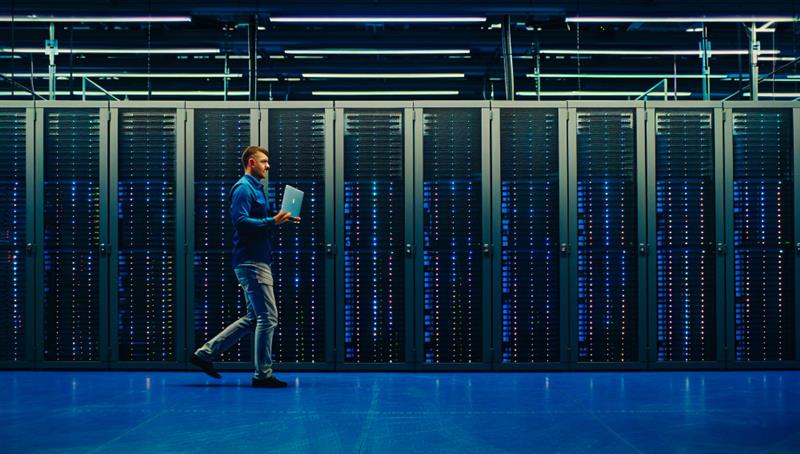How Hyperscale Data Centers are Shaping Global Connectivity?
Hyperscale data centers are revolutionizing global connectivity by providing scalable, secure, and energy-efficient infrastructure that supports AI, cloud computing, IoT, and 5G technologies. These facilities enable rapid data processing, resilient operations, and cost-effective solutions for businesses worldwide. With growing demand from cloud services, fintech, and real-time applications, hyperscale centers are evolving through innovations like software-defined networking, edge computing, and AI-driven optimization.
Did you know that hyperscale data centers play a key role in technological revolutions? Although these may be behind the scenes, these centers are redefining life like no other.
It will never be wrong to call data centers the cornerstones of digital services that shape global connectivity. They also manage huge flows of data to ensure a proper supply of computing power for artificial intelligence. This also includes the development of hybrid cloud services and advanced IT systems.
Hyperscale data centers provide the foundation for global SaaS platforms, real-time analytics, IoT deployments, and blockchain verification, serving as the underlying structure for nearly every major digital innovation of this decade.
That is why the demand for hyperscale data centers has boomed in recent years. It is specifically driven by the growth of cloud service providers like Microsoft Azure and Google Cloud. Global content delivery networks, social media giants, and financial technology platforms also rely on hyperscale infrastructure to minimize latency and ensure regulatory compliance in different jurisdictions.
What is a Hyperscale Data Center?
A hyperscale data center is a large facility handling massive amounts of dedicated servers, VPS servers, data, computing, and other relevant storage needs. These centers can provide extreme scalability, which means they can quickly expand or reduce their resources to meet user demands.
Unlike regular data centers, the hyperscale ones have more than 5,000 servers and span over 10,000 square feet. They can also process higher volumes of data with faster network connections. This helps them handle increasing amounts of information businesses need. Network fabrics inside these facilities are designed with ultra-high bandwidth and redundant links, making it possible to achieve line-rate data transfers even as traffic spikes unpredictably.
Currently, the hyperscale data center market is projected to grow from $54.74 billion in 2025 to $262.09 billion by 2032 with a CAGR of 25.1%. This also proves the rising demand for these data centers to improve global connectivity. The exponential increase is fueled by everything from smart city projects and telemedicine to cryptocurrency mining and augmented reality platforms, all of which require uninterrupted, scalable digital infrastructure.
Key Benefits of Hyperscale Data Centers
Knowing what hyperscale data centers do is not enough. You must also know their key benefits to leverage their capabilities for your business.
Here are the following:
Dynamic Scalability
You can quickly add more resources to hyperscale data centers. This means you may add or move resources around as needed without having to deal with downtime or complicated upgrades. This flexibility lets any data center grow quickly when needed.
Most people utilize automated orchestration platforms, which are frequently powered by machine intelligence, to spread and optimize workloads across thousands of virtual and physical nodes.
Cloud-level Resiliency
Hyperscale data centers are very reliable and resilient. Yes, they allow businesses to enjoy 99.999% availability, which means systems are almost always up and running. This is only achievable due of smart load balancing and the center's capacity to add more resources without any problems. This level of resilience is made possible by redundant power feeds, backup generators on site, and disaster recovery systems that are spread across many locations.
Cybersecurity at Scale
Data centers often need strong security measures because they store sensitive information. Most companies implement a zero-trust security design to ensure better security, meaning that no one is trusted by default.
Businesses aiming to protect their digital infrastructure should explore powerful cybersecurity software that supports real-time threat detection, encryption, and compliance enforcement. These tools help reinforce zero-trust principles and safeguard data across distributed environments.
The system often includes advanced threat protection and security structures to handle high traffic and low delays. This helps keep data safe. Encryption at rest and in transit, distributed denial-of-service mitigation, and continuous real-time monitoring are standard features in hyperscale environments.
Operational Simplicity
Hyperscale data centers focus on integrating systems to improve business performance. This integration makes managing centers simpler and more efficient. The process also involves reducing the number of independent parts dealt with by businesses.
To streamline deployment and monitoring across hybrid environments, organizations often utilize advanced cloud management software. These platforms provide centralized dashboards for overseeing workloads, automating scaling, and ensuring service uptime at scale.
Unified management consoles and software-defined infrastructure allow operators to handle physical and virtual resources from a single dashboard, simplifying troubleshooting and upgrades.
Cost Efficiency
Hyperscale data centers often offer services at low prices. They leverage intelligent load balancing to ensure all computing resources are utilized, rather than half of them having to sit idle. This approach leads to excellent savings for industries, especially in hardware, energy, and space. Bulk procurement, modular hardware, and advanced power usage effectiveness (PUE) ratings all help reduce operational expenditure.
Enhanced Economies of Scale
Hyperscale data centers can achieve lower costs because of their massive size. They use their computing power to offer Service Level Agreements (SLAs) and better pricing than typical data centers. By deploying containerized server units and using direct-to-chip cooling, operators reduce both capital and ongoing operational costs.
Balanced Workloads
Hyperscale data centers can quickly spread workloads across many servers. This stops one server from getting too busy. It also lowers the chance of overheating, which could harm the performance of other servers. Some load balancers use AI-based predictive analytics to guess what will happen and move workloads around to prevent bottlenecks.
Better use of energy
Even though they are quite big, hyperscale data centers use less energy. They also use energy again and make sure that the air flows well to keep servers cool. This also means that energy expenses are lower than at other traditional data centers. Facilities often use liquid cooling, waste heat recovery, and on-site renewable energy generation to lower their carbon footprint even more.
Future Trends in Hyperscale Data Centers
Hyperscale data centers are excellent ways to enhance connectivity, and several other businesses will also be dependent on them in the future following the trends below:
Cloud and Virtualization Technologies
Virtualization often allows you to create virtual versions of physical hardware and resources. This will mean more flexibility and scalability. You can easily deploy services faster and handle growing demand by leveraging fewer physical resources.
Containers, serverless computing, and infrastructure-as-code are becoming default deployment models, making it easier to manage multi-cloud and hybrid environments.
Software-Defined Networking (SDN)
SDN changes the way hyperscale data centers handle their networks. This separates network control from physical hardware, which makes it easier to handle from one place and gives you more options.
It's easy to change resources, which makes it easier to add new services and improve network performance. Operators now have considerably more control over both security and speed because of network slicing, micro-segmentation, and programmable network pathways.
AI and Machine Learning Integration
In the future, hyperscale data centers will rely on AI and ML as their main tools. These technologies assist in figuring out what the system needs, make workloads more efficient, and do simple tasks automatically.
As AI applications proliferate, data centers need to add more computing capacity to keep up with greater processing needs. AI is increasingly being utilized for predictive maintenance, thermal mapping, and real-time energy optimization, which means fewer outages and reduced costs.
Effects of 5G and Edge Computing
5G technology offers quicker data speeds and less lag. This, in turn, makes it easier to connect and speeds up data flow. On the other hand, edge computing puts data processing closer to the people who use it. This lightens the pressure on central data centers and makes real-time apps possible. Hyperscale data centers are being connected to edge nodes so that they can be used for very low-latency applications like self-driving cars, industrial automation, and real-time IoT analytics.
Bottom Line
Hyperscale data centers offer businesses the agility to handle storage, management and processing workloads efficiently for cloud service data. Moreover, the consolidation of computing resources into a single facility, virtualization, and software-defined infrastructures brings about economies of scale and increases the profitability of these data centers.
In the coming years, we expect even greater integration between hyperscale cores and decentralized edge nodes, automated by AI and secured with next-generation encryption.

Subscribe & get all related Blog notification.





Post your comment